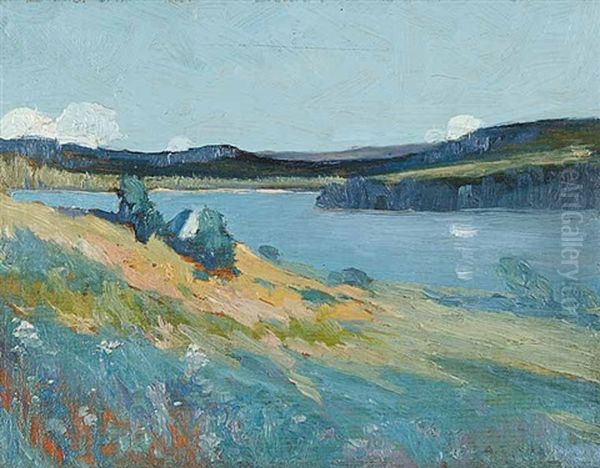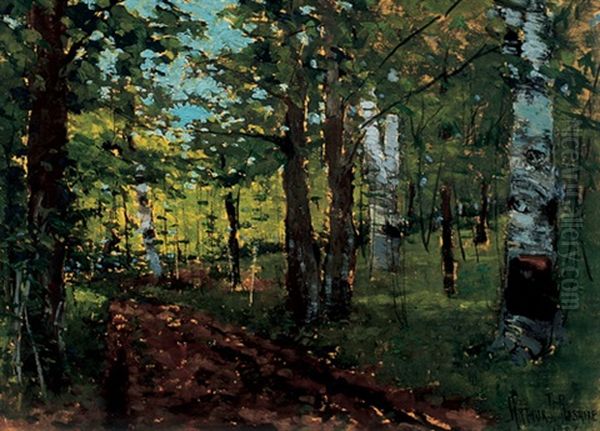Arthur Dominique Rozaire (1879-1922) stands as a significant, albeit sometimes overlooked, figure in the narrative of early 20th-century Canadian art. A dedicated painter, Rozaire carved out a career during a transformative period in North American art, contributing notably to the burgeoning Impressionist movement within Canada and leaving a distinct mark through his evocative landscapes and, more unusually for his time and place, his exploration of the female nude. His relatively short life belied a productive career that saw him active in both his native Canada and, later, in the sun-drenched climes of California.
Early Life and Artistic Formation
Born in 1879 in Canada, Arthur Dominique Rozaire emerged as an artist during a period when Canadian art was seeking its own voice, distinct from European traditions yet inevitably influenced by them. While specific details about his early training are not always exhaustively documented in popular accounts, it is clear that he absorbed the influences of his time. The late 19th and early 20th centuries were a period of immense artistic ferment, with Impressionism, Post-Impressionism, and various other modern art movements challenging the established academic norms.
For Canadian artists like Rozaire, the pull of Paris, the epicenter of the art world, was strong. Many of his contemporaries, such as James Wilson Morrice (1865-1924) and Maurice Cullen (1866-1934), spent considerable time in France, directly engaging with Impressionist and Post-Impressionist aesthetics. These artists, upon their return or through their correspondence and exhibited works, played a crucial role in disseminating these new artistic ideas within Canada. Rozaire, whether through direct exposure or through the work of these influential peers, embraced the Impressionist ethos.
Embracing Impressionism in Canada

Impressionism, with its emphasis on capturing the fleeting effects of light and atmosphere, found fertile ground in the varied Canadian landscape. Rozaire became one of the notable proponents of this style in Canada. His approach was characterized by a vibrant palette, broken brushwork, and a keen sensitivity to the nuances of light, particularly in his depictions of the Canadian wilderness and rural scenes. He shared this interest with other Canadian Impressionists like Marc-Aurèle de Foy Suzor-Coté (1869-1937), known for his luminous snow scenes and figure studies, and Helen McNicoll (1879-1915), whose depictions of sunlight and modern life were groundbreaking.
Rozaire’s contribution to Canadian Impressionism was significant. He was not merely an imitator of French styles but adapted Impressionist techniques to convey the unique character of the Canadian environment. This often meant tackling subjects like snow-covered landscapes, a theme also masterfully explored by artists like Clarence Gagnon (1881-1942), or the distinctive light of the Quebec countryside. His work demonstrated a commitment to plein air painting, or painting outdoors, a hallmark of the Impressionist movement pioneered by artists like Claude Monet (1840-1926) and Camille Pissarro (1830-1903).
Key Themes and Subjects in Rozaire's Oeuvre
Rozaire's body of work primarily revolved around landscapes, a genre that has historically held a central place in Canadian art, from the early topographers to later iconic groups like the Group of Seven. His paintings often captured the changing seasons, from the crisp air of winter to the gentle haze of a misty morning.
One of his notable works, Snow Landscape with Sleigh (reportedly dated 1907 by some sources, though specific dating can be elusive), exemplifies his skill in rendering the subtle tonalities of snow and the cool light of a winter's day. The inclusion of a sleigh adds a narrative element, a touch of human presence within the vastness of nature, reminiscent of the genre scenes of earlier Canadian artists like Cornelius Krieghoff (1815-1872), though Rozaire's treatment is distinctly Impressionistic.
Another significant piece, Misty Morning, Clam Diggers St. Lawrence, showcases his ability to capture atmospheric effects. The soft, diffused light and the muted palette convey the quietude and ethereal beauty of the scene. This focus on atmosphere and light aligns him with the broader Impressionist concerns of artists like Alfred Sisley (1839-1899), who was renowned for his delicate landscape paintings.
Lac St-Joseph is another title that appears in records of his work, suggesting his affinity for painting water and its reflective qualities, a common preoccupation for Impressionist painters. The interplay of light on water, the broken reflections, and the sense of tranquility are all elements that would have appealed to his Impressionist sensibilities.
The Intriguing Case of Birch Forest (1914)

The painting Birch Forest, dated 1914, is often cited as a key example of Rozaire's Impressionistic technique. Descriptions of this work often highlight his use of broad, confident brushstrokes to build up the composition, capturing the dappled light filtering through the trees and the textured bark of the birches. The emphasis is on the overall visual sensation rather than minute detail, a core tenet of Impressionism.
Some more unusual interpretations or descriptions of his technique, occasionally surfacing in less formal art discussions, have mentioned a "shrink-wrapping" effect, particularly in relation to rendering animal forms with minimal soft tissue to emphasize underlying structures. However, applying this specific description to a landscape like Birch Forest seems incongruous and might stem from a misunderstanding or a conflation with other artists or specific, perhaps atypical, works by Rozaire. His primary legacy in landscape painting rests on his skillful application of Impressionist principles of light, color, and brushwork to convey the essence of the natural world.
A Bold Foray: The Female Nude
Beyond landscapes, Arthur Dominique Rozaire made a notable, if less voluminous, contribution to a genre that was relatively rare and often controversial in early 20th-century Canadian art: the female nude. In a society that was still largely conservative in its artistic tastes, tackling the nude required a degree of boldness. Rozaire’s engagement with this subject placed him among a progressive minority of Canadian artists who sought to explore the full range of academic and modern artistic themes.
His nudes, like his landscapes, would have been approached with an Impressionist's eye for light and form, likely emphasizing the play of light on skin and the harmonious integration of the figure within its setting. This exploration aligns him with European Impressionists like Edgar Degas (1834-1917) or Berthe Morisot (1841-1895), who, though known for different primary subjects, also depicted the human form with a modern sensibility. In Canada, artists like Suzor-Coté also produced significant nudes, contributing to the gradual acceptance of the genre.
The California Sojourn: New Light, New Landscapes
At some point in his career, Rozaire moved to California, a state that was also experiencing an artistic awakening, particularly with the rise of California Impressionism. The brilliant, consistent light and diverse landscapes of California attracted many artists from the East Coast and Europe. Artists like Guy Rose (1867-1925), William Wendt (1865-1946), and E. Charlton Fortune (1885-1969) were instrumental in developing a distinct regional style of Impressionism there.
Rozaire's time in California would have exposed him to this vibrant art scene and a different quality of light and landscape than he was accustomed to in Canada. While specific works from this period might be less widely known than his Canadian scenes, it is reasonable to assume that he continued to paint landscapes, perhaps adapting his palette and technique to capture the unique atmospheric conditions of the American West Coast. This move reflects a broader pattern of artists seeking new environments and inspirations, a common thread in the careers of many painters of his generation, including American Impressionists like Childe Hassam (1859-1935) or William Merritt Chase (1849-1916) who also painted in various locales.
Artistic Techniques and Stylistic Hallmarks
Rozaire's artistic style is firmly rooted in Impressionism. His paintings typically exhibit several key characteristics:
1. Broken Brushwork: He applied paint in short, distinct strokes, allowing colors to mix optically in the viewer's eye rather than being fully blended on the palette. This technique contributes to the vibrancy and dynamism of his surfaces.
2. Emphasis on Light and Atmosphere: Capturing the ephemeral qualities of light at different times of day and in various weather conditions was paramount. This is evident in his snow scenes, misty mornings, and sun-dappled forests.
3. Vibrant Palette: While capable of subtle tonal harmonies, especially in snow scenes, Rozaire often employed a brighter palette than many of his more traditional predecessors, reflecting the Impressionist interest in the scientific theories of color and light.
4. Plein Air Practice: Like his Impressionist counterparts, Rozaire likely painted much of his work outdoors, directly observing his subjects to capture their immediate visual impact.
5. Composition: His compositions, while grounded in observation, often show a thoughtful arrangement of forms to create a harmonious and engaging image.
His approach was less radical than some of the Post-Impressionist developments seen in Europe with artists like Vincent van Gogh (1853-1890) or Paul Gauguin (1848-1903), but it represented a significant step forward from the more academic styles that had previously dominated Canadian art.
Rozaire's Place in Art History and Market Recognition
Arthur Dominique Rozaire's career, though cut short by his death in 1922 at the relatively young age of 42 or 43, left a discernible impact. He was part of a crucial generation that helped to modernize Canadian art, paving the way for later movements, including the iconic Group of Seven, whose members like Lawren Harris (1885-1970) and A.Y. Jackson (1882-1974) would further redefine Canadian landscape painting, albeit with a more Post-Impressionist and uniquely nationalistic vision.
The enduring appeal of Rozaire's work is evidenced by its presence in art auctions. His paintings, such as Snow Landscape with Sleigh and Misty Morning, Clam Diggers St. Lawrence, have appeared in sales of important Canadian art, often achieving respectable prices. For instance, Misty Morning, Clam Diggers St. Lawrence was noted to have an auction estimate of $6,000 to $8,000 in a 2015 sale. Such figures indicate a sustained interest from collectors and affirm his status as a recognized Canadian Impressionist.
His works are held in various private and public collections, ensuring that his contribution to Canadian art history continues to be appreciated. While perhaps not as widely known internationally as some of his French Impressionist contemporaries, within the context of Canadian art, Rozaire is an important figure whose work reflects both the international currents of his time and a genuine engagement with his local environment.
Legacy and Conclusion
Arthur Dominique Rozaire's legacy lies in his skillful and sensitive adoption of Impressionist principles to depict the Canadian landscape and, to a lesser extent, the human figure. He was a bridge figure, helping to transition Canadian art from 19th-century academicism towards a more modern visual language. His dedication to capturing the nuances of light and atmosphere, his vibrant brushwork, and his willingness to explore subjects like the female nude mark him as a progressive artist for his time.
Though his life was brief, his artistic output contributed to a richer, more diverse Canadian art scene. He stands alongside figures like Maurice Cullen, Suzor-Coté, and Helen McNicoll as one of the key artists who brought the light and energy of Impressionism to Canada, forever influencing how the nation's landscapes and identity would be portrayed. His paintings remain a testament to a period of artistic exploration and a personal vision dedicated to capturing the beauty of the world as he perceived it, moment by fleeting moment. His work invites contemporary viewers to appreciate not only the Canadian and Californian landscapes he depicted but also the artistic currents that shaped his distinctive and appealing style.